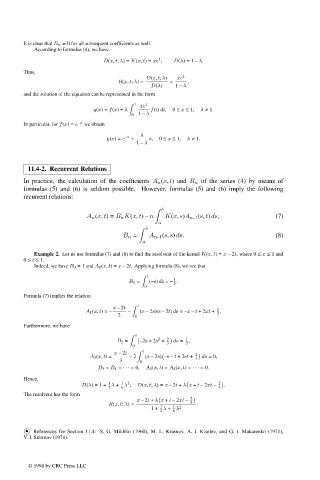Page 554 - Handbook Of Integral Equations
P. 554
It is clear that B n = 0 for all subsequent coefficients as well.
According to formulas (4), we have
t
D(x, t; λ)= K(x, t)= xe ; D(λ)=1 – λ.
Thus,
D(x, t; λ) xe t
R(x, t; λ)= = ,
D(λ) 1 – λ
and the solution of the equation can be represented in the form
1 xe t
y(x)= f(x)+ λ f(t) dt, 0 ≤ x ≤ 1, λ ≠ 1.
0 1 – λ
In particular, for f(x)= e –x we obtain
λ
y(x)= e –x + x, 0 ≤ x ≤ 1, λ ≠ 1.
1 – λ
11.4-2. Recurrent Relations
In practice, the calculation of the coefficients A n (x, t) and B n of the series (4) by means of
formulas (5) and (6) is seldom possible. However, formulas (5) and (6) imply the following
recurrent relations:
b
A n (x, t)= B n K(x, t) – n K(x, s)A n–1 (s, t) ds, (7)
a
b
B n = A n–1 (s, s) ds. (8)
a
Example 2. Let us use formulas (7) and (8) to find the resolvent of the kernel K(x, t)= x – 2t, where 0 ≤ x ≤ 1 and
0 ≤ t ≤ 1.
Indeed, we have B 0 = 1 and A 0 (x, t)= x – 2t. Applying formula (8), we see that
1
1
B 1 = (–s) ds = – .
2
0
Formula (7) implies the relation
x – 2t 1
A 1 (x, t)= – – (x – 2s)(s – 2t) ds = –x – t +2xt + 2 .
2 0 3
Furthermore, we have
2
B 2 = 1 –2s +2s + 2 ds = 1 ,
3 3
0
x – 2t 1
A 2 (x, t)= – 2 (x – 2s) –s – t +2st + 2 ds =0,
3 0 3
B 3 = B 4 = ··· =0, A 3 (x, t)= A 4 (x, t)= ··· =0.
Hence,
2
D(λ)=1 + 1 λ + 1 λ ; D(x, t; λ)= x – 2t + λ x + t – 2xt – 2 .
2 6 3
The resolvent has the form
x – 2t + λ x + t – 2xt – 2
R(x, t; λ)= 3 .
1+ 1 λ + 1 λ 2
2 6
•
References for Section 11.4: S. G. Mikhlin (1960), M. L. Krasnov, A. I. Kiselev, and G. I. Makarenko (1971),
V. I. Smirnov (1974).
© 1998 by CRC Press LLC
© 1998 by CRC Press LLC
Page 537

